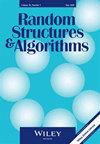关于低阶组合装配的最大零件尺寸
IF 0.8
3区 数学
Q4 COMPUTER SCIENCE, SOFTWARE ENGINEERING
引用次数: 1
摘要
我们给出了可分解组合结构近似的一般框架,适用于大小n $$ n $$和组件个数k $$ k $$指定的情况。特别是对于装配体,这涉及到泊松过程,在适当选择参数的情况下,泊松过程可以看作是鞍点近似的扩展。当秩(定义为r:=n−k $$ r:= n-k $$)相对于尺寸n $$ n $$较小时,我们通过分析组件结构来说明泊松过程描述对组件的使用。除了指数生成函数收敛半径为零的退化情况外,对于t∈(0,∞)$$ t\in \left(0,\infty \right) $$和r =1,2,…$$ \ell =1,2,\dots $$:当r≤α α $$ r\asymp {n}^{\alpha } $$对于固定的α∈(lz +1, lz +1, lz +2) $$ \alpha \in \left(\frac{\ell }{\ell +1},\frac{\ell +1}{\ell +2}\right) $$,最大分量的大小L1 $$ {L}_1 $$在概率上收敛于lz +2 $$ \ell +2 $$;当r ~ tn n r /(r +1) $$ r\sim t\kern0.3em {n}^{\ell /\left(\ell +1\right)} $$时,我们有(L1∈r {+1, r +2})→1 $$ \mathbb{P}\left({L}_1\in \left\{\ell +1,\ell +2\right\}\right)\to 1 $$,其选择由大小为r +2的分量个数的泊松极限分布支配$$ \ell +2 $$。这是最近观察到的,对于情况下,1 $$ \ell =1 $$和置换和集合分区的特殊情况,使用Chen-Stein近似的攻击和对齐的指标在车的位置。本文章由计算机程序翻译,如有差异,请以英文原文为准。
On the largest part size of low‐rank combinatorial assemblies
We give a general framework for approximations to decomposable combinatorial structures suitable to the situation where the size n$$ n $$ and the number of components k$$ k $$ are specified. In particular for assemblies, this involves a Poisson process, which, with the appropriate choice of parameter, may be viewed as an extension of saddlepoint approximation. We illustrate the use of the Poisson process description for assemblies by analyzing the component structure when the rank, defined as r:=n−k$$ r:= n-k $$ , is small relative to the size n$$ n $$ . There is near‐universal behavior, in the sense that, apart from degenerate cases where the exponential generating function has radius of convergence zero, we have for t∈(0,∞)$$ t\in \left(0,\infty \right) $$ and ℓ=1,2,…$$ \ell =1,2,\dots $$ : when r≍nα$$ r\asymp {n}^{\alpha } $$ for fixed α∈(ℓℓ+1,ℓ+1ℓ+2)$$ \alpha \in \left(\frac{\ell }{\ell +1},\frac{\ell +1}{\ell +2}\right) $$ , the size L1$$ {L}_1 $$ of the largest component converges in probability to ℓ+2$$ \ell +2 $$ ; when r∼tnℓ/(ℓ+1)$$ r\sim t\kern0.3em {n}^{\ell /\left(\ell +1\right)} $$ , we have ℙ(L1∈{ℓ+1,ℓ+2})→1$$ \mathbb{P}\left({L}_1\in \left\{\ell +1,\ell +2\right\}\right)\to 1 $$ , with the choice governed by a Poisson limit distribution for the number of components of size ℓ+2$$ \ell +2 $$ . This was recently observed, for the case ℓ=1$$ \ell =1 $$ and the special cases of permutations and set partitions, using Chen–Stein approximations for the indicators of attacks and alignments in rook placements.
求助全文
通过发布文献求助,成功后即可免费获取论文全文。
去求助
来源期刊

Random Structures & Algorithms
数学-计算机:软件工程
CiteScore
2.50
自引率
10.00%
发文量
56
审稿时长
>12 weeks
期刊介绍:
It is the aim of this journal to meet two main objectives: to cover the latest research on discrete random structures, and to present applications of such research to problems in combinatorics and computer science. The goal is to provide a natural home for a significant body of current research, and a useful forum for ideas on future studies in randomness.
Results concerning random graphs, hypergraphs, matroids, trees, mappings, permutations, matrices, sets and orders, as well as stochastic graph processes and networks are presented with particular emphasis on the use of probabilistic methods in combinatorics as developed by Paul Erdõs. The journal focuses on probabilistic algorithms, average case analysis of deterministic algorithms, and applications of probabilistic methods to cryptography, data structures, searching and sorting. The journal also devotes space to such areas of probability theory as percolation, random walks and combinatorial aspects of probability.
 求助内容:
求助内容: 应助结果提醒方式:
应助结果提醒方式:


